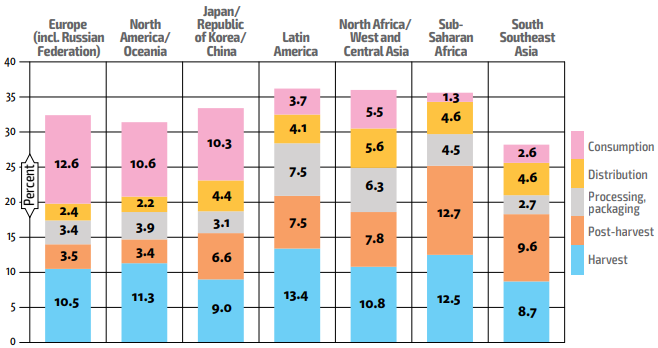The losses and waste that regularly occur from production to consumption of agricultural products severely impact their costs.
According to the Food and Agriculture Organization of the United Nations, there is evidence that about 1.3 billion tons annually, or a third of the edible portion of food initially intended for human consumption, is lost or wasted.
In North America and Oceania, 10.6% of food is lost or wasted in consumption, 2.2% in distribution, 3.9% in processing and packaging, 3.4% in post-harvest, and 11.3% at harvest, as shown below.
Although the loss in final consumption happens after the last commercial transaction, it also impacts cost and prices as both institutional buyers and final consumers consider it when making their purchases.
A significant part of these losses stems from the fact that food can present non-conformities or inadequacies that are harmful to human, animal, and plant health and the environment.
Those threats made it necessary to carry out food security procedures at different stages and by distinct agents in the production chain, including :
– by rural producer himself, assisted by veterinarians, agronomists, zootechnicians, and agricultural technicians, embodying what is called “good rural practices” like the Good Agricultural Practices (GAP) and Good Handling Practices (GHP) audited by the USDA Audit Program;
– by food and non-food processing companies through their Quality Management Systems (QMS), Good Manufacturing Practices (GMP), Standard Operating Hygiene Procedures (PPHO), Microbiological Risk Assessment (MRA), Hazard Analysis and Critical Control Points (HACCP), and Product Traceability programs;
– by food safety and quality certifying agencies that verify adherence to quality norms and standards, such as those of the International Organization for Standardization (ISO), Global Food Safety Initiative (FSSC), British Retail Consortium (BRC), Safe Quality Food (SQF), International Featured Standard (IFS), Japanese Industrial Standards Committee (JISC), Muslim religion (Halal), and Jewish religion (Kosher).
– by public agencies, like the US Food & Drug Administration (FDA), Food Safety Inspection Service (FSIS), and European Food Safety Authority (EFSA).
– by customers, such as large national buyers and foreign importers, through visual inspections, laboratory analysis, and conformity checks in general.
These procedures add costs to all parties involved – producers, processors, intermediaries, or final consumers – reflected in the prices charged.
C. L. Eckhard, author of Pricing in Agribusiness: setting and managing prices for better sales margins.








 Claudio Luiz Eckhard is a former professor, business consultant, and author of the books “Ajustando o Rumo”[Adjusting the Business Course], “Gestão pela Margem”[Management by Margin], “A Empresa Saudável”[The Healthy Company], and “Pricing no Agribusiness”[Pricing in Agribusiness].
Claudio Luiz Eckhard is a former professor, business consultant, and author of the books “Ajustando o Rumo”[Adjusting the Business Course], “Gestão pela Margem”[Management by Margin], “A Empresa Saudável”[The Healthy Company], and “Pricing no Agribusiness”[Pricing in Agribusiness].


